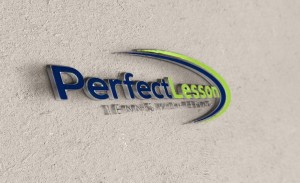
Match Report
Blanche Lagrisola
Rizal Memorial Stadium , Manila, Philippines
Junior Age Tournament
21 April 2016
I observed one of Blanche’s matches (which she won) , and found the following items in her game which would need improvement if she desired to achieve maximum improvement.
I have also prioritised those items ; first items listed being the most important (or in other words, her biggest weaknesses).
Serve
I see this to be Blanche’s biggest weakness, and probably the one which will take the longest to fix. But fix it she must because from now on most opponents will be able to attack Blanche’s current serve, put Blanche on the defensive AND put massive pressure on her second serve.
The only way to stop this type of pressure from the opponent is to have a first serve with higher percentages and a top-spin second serve which can be hit hard and hold off the opponent.
Blanche’s problems on the serve are all technical (thus can be fixed).
Her current serve is all side spin which sends the ball most times to the opponent’s forehand. She is hitting heavily around the right hand side of the ball. She has almost no topspin on her serve. This means her racket/strings are not passing over the top of the ball as she makes contact.
This then is the order of items to be fixed and worked on.
1. Swinging through the ball on ‘the Golden Line”.
2. Increasing the height of contact.
3. Adding more wrist snap
4. Making sure the toss for a first serve is exactly in the correct place.
Only when the above items are reasonably correct would Blanche start work on the topspin second serve.
She would then have to improve the following items:
1. Toss must be back and left.
2. Height of contact must not drop low at all
3. She will have to learn to swing up/hit up much, much more than she currently is.
4. Be able to kick the ball into the side fence.
On an item of interest, most players do not realize how much over the ball the pros are when they are slicing out wide to make an ace.
Blanche is actually squatting down in the middle of her serve, instead of creating a body line like a large bow. Note well, most times the player should not have to be taught to do the bow, it should begin to take place naturally as a result of the player doing all other serve mechanics correctly. Saying it differently, if a player learns the correct serve fundamentals the body will ask for more “bow”. The player will not have to think about it.
Below is a diagram showing the Golden Line. For a first serve the ball toss needs to be on this line, and the swing and body movement should also be following this line ( as much as the body will permit).
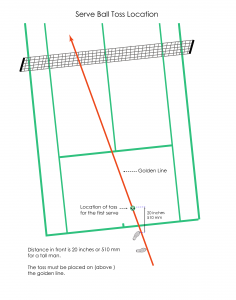
The Golden Line
The sketch below shows the pros making contact at full extension.
Notice also the straight line between left leg and right arm/racket.
![sk--29E--draft1[2]](http://perfectlesson.com/perfectlesson/wp-content/uploads/sites/3/2016/04/sk-29E-draft12-132x300.png)
Full extension
Wrist snap enables the player to hit up much more, hit the ball harder, but still keep 100% in. Many sports utilise this action. The first sketch below shows one of the WTA players using wrist snap and coming over the ball (not under, nor around the side of the ball). The second sketch below shows two American Football (NFL) players throwing the football with spin. Note the same wrist action.
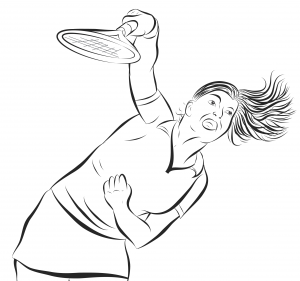
Wrist snap.
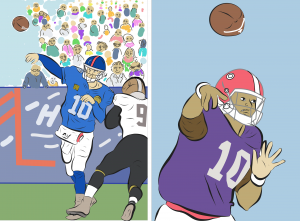
NFL “wrist snap”.
For the topspin second serve Blanche will need to have a different ball toss location (position D), swing up much more and use more wrist in order to keep the required amount of spin AND kick the ball to her right.
The sketch below shows the location of the ball toss for Blanche’s “new” second serve.
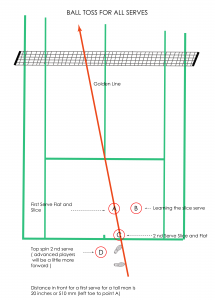
Placement of the ball toss
The following sketch shows the optical illusion for the topspin second serve. The racket/arm swing direction is very much up AND moving slightly left to right with the result that one is hitting up and across the ball as though the player were trying to hit the ball over the tree, which is off to the right of the court.

The optical illusion
Speed around court
Blanche needs to become as fast as Serena Williams. Thus Blanche needs to do specific speed improvement drills. Short distance sprinting, five, ten, twenty and thirty meters. (nothing over 30 meters). There are many of these drills, but to begin with I suggest she starts with this version of the Fan Drill. See below.
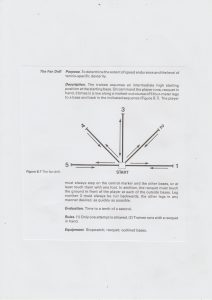
The Fan Drill
Some of the tennis pros have got this drill down to under 40 seconds; can you ?
The American NFL players (male) use a 40 yard sprint test.
Their equivalent time for a 30 meter sprint is 3.48 seconds. The fastest female sprinter in the world runs the 100 meters in 10.49 seconds. That equivalent for 30 meters is 3.15 seconds. She is definitely faster than the male NFL players.
Blanche needs to get times close to the above mentioned athletes.
Take opportunities to come to net
Many times Blanche missed the opportunity to make an approach shot and come to net. This is because she is not sure of her net play; and in being hesitant, when she did get to the shorter ball she did not go far enough up the court to that ball. The further back from the net when a player hits the ball leads to less chance of hitting penetrating shots and thus less chance of winning the point.
Volleys
Blanche will need to master the forehand and backhand volleys. She cannot go wrong by copying Serena Williams. Serena is a great volleyer and handles all volleys well (standard, low volley and high volley ).
The main requirements for good volleys is to master the following.
Perfect ball watching.
The player must glue their eyes on the ball. See the following sketch.
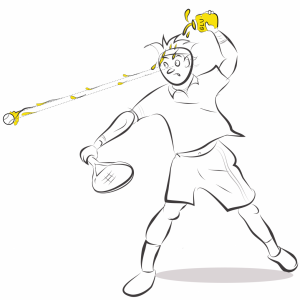
Glue eyes on the ball
Point of Contact in front.
The sketch below shows how far in front the player should make contact.
![12D-draft4[1]](http://perfectlesson.com/perfectlesson/wp-content/uploads/sites/3/2016/04/12D-draft41-297x300.png)
Distance in front for the point of contact
Learn to block the ball.
Blocking means that your racket remains steady, holds its ground and refuses to permit the ball to make any further forward progress.
On a pure 100% block, your racket would not move at all, simply hold steady like a brick wall. This will work if someone blasts the ball at you. However if the ball is travelling slowly the player will need to generate some power, so there will be a small forward swing and within that the player must punch the ball (not make a baseball swing). Within the punch though the racket will stop at the point of contact. A player learning the volley is best to say to themselves “make NO follow through at all”. Now this is impossible and incorrect if you are punching the ball, but in my experience this is the wisest thing a learning player can say to themselves…..along with a similar statement to themselves “NO backswing”. Perfection will be a very small backswing !!
A feeling of blocking would come from the player visualising hammering on a door. See sketch below.
![Sk-12-c-draft7[1]](http://perfectlesson.com/perfectlesson/wp-content/uploads/sites/3/2016/04/Sk-12-c-draft71-243x300.png)
Blocking the Volley
If you volley correctly you will develop a different feel to the ball at the point of contact. The correct feel would be one of the ball bouncing off a brick wall. (What would the wall feel ?) On a correctly executed groundstroke the feeling is one of carrying the ball forward and maintaining contact with the ball for several mini seconds.
Keep the racket head above the wrist.
Learn to have a very, very small backswing and almost no follow through (block). The sketch below shows Serena Williams keeping the racket head above the wrist throughout the whole volley.
![Sk-14-draft-A[3]](http://perfectlesson.com/perfectlesson/wp-content/uploads/sites/3/2016/04/Sk-14-draft-A3-204x300.png)
Racket head above the wrist
Smash
Blanche will probably have learnt by now that the serve and the smash are basically identical. If she has a good serve, she will have a good smash.
The main difference between the two is this. On the serve the player must make sure their left arm is executing perfectly (tossing the ball correctly). On the smash the player must make sure that their feet are executing correctly (finding the correct place on the court).
Other than that Blanche would say to herself “the perfect smash is the same as the first serve”. So Blanche simply must position herself to the ball (on the smash) , making the same relative position to the ball as in the first serve. Having done that, Blanche can then hit the ball hard and probably get an outright winner !
Approach shots
I think now I should bring up a big learning point for the novice net player which will apply to all approach shots and all volleys.
You do not have to hit a winner on your first hit !!!!!
In the main I would say there are three possible situations.
You may have a ball (easy ball) where you have the chance to literally attack the ball and make your shot penetrate. This may result in an outright winner. In another drill we call this a green light ball.
But then there is another ball which is not as easy, however that is not to say you should only junk the ball back down the middle of the court. You still can make your shot penetrate but you have to think more about placement and depth and not hitting at full power. In another drill we call this a yellow light ball.
And then we have the volley where your opponent has hit a very good shot. You will have to learn how to get out of trouble with this volley. Probably it is also a low volley. In another drill we call this a red light ball.
Remember also, a net attack must follow the correct percentages. This means that some of the time your opponent will pass you outright or hit a winning lob. But if you execute your technique correctly and follow the correct percentage play for all approach shots and volleys…..you will win more than 50% of the points. And that is all that is needed with a consistent net attack. It is quite different percentages to your groundstrokes.
I can guarantee your net attack will be successful if you follow the percentages. I know it well as I grew up playing on grass and by the time I was eighteen I had a big serve and volley attack. My best performance in using a serve / volley attack actually came on a clay court. I was playing the number one clay court player in the world (at that time) in the final of the Chilean Championships in South America on red clay. It was a best of five sets match and I lost the first set 4-6….BUT….I felt I could not win by trading groundstroke for groundstroke (he was too good for me at that game). So I changed tactics and served and volleyed EVERY point on my serve. I executed near perfectly and from that moment on I did not drop serve for the rest of the match. I won 4-6,6-4,6-4,6-4. As I said I did not drop serve in the last three sets. I broke him once in each of the last three sets, mainly by chipping and charging on his second serve.
So let us go into a bit more detail. As I said the tactics for approach shots is almost the same as for volleys.
On the approach, where should you hit the ball ? Generally speaking crosscourt is dangerous. If you can guarantee an outright winner or a shot which forces your opponent into an error, then hit crosscourt. But always remember, if your opponent reaches the ball and gets balanced you have created more angle for your opponent. Thus it will be easier for the opponent to pass you. When you hit down the line your opponent has less angle to play with.
So the major rules are: if you can hit a truly penetrating shot crosscourt…….go crosscourt.
BUT, if you are in doubt as to how much penetration you will get, then go down the line.
Most times when we go down the line we are not expecting that shot to be a winner. We are hoping that the next shot (our first volley) will make the winning hit. This is often called the 1-2 punch. Hence placement and depth are more important on the down the line approach shot ( much more important than power).
Here are a few sketches to help you.
The following sketch shows you that anytime you hit from behind the baseline AND you want to hit an outright winner, you yourself can create an angle of 17.1 degrees. Obviously this will be almost impossible to make this winner against a quick , fast opponent.

Maximum angle baseline
However if you can be closer to the net and have the ball a little higher (like a high forehand volley) you can create an angle of 50 degrees. Now you have a very good chance of making your outright winner.
Also refer to some of my other comments about not getting up to the short ball enough.
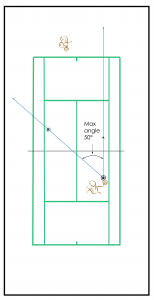
Maximum angle net
The following sketch shows what it looks like to your opponent IF they reach your crosscourt shot. From this position on the court your opponent can use an angle of 47 degrees.

Beware crosscourt volleys
The following sketch shows the two different angles the passer can use against you. The first, a normal crosscourt volley. From that position on the court your opponent can use a 26.5 degree angle. The second scene, a normal approach or volley down the line. From that position on the court your opponent has an angle of only 18 degrees
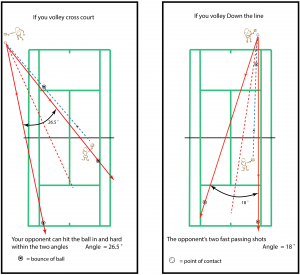
Angles created
If you have a high volley, back some distance from the net, you will always be best to hit down the line. But depth here is critical !
See following sketch.
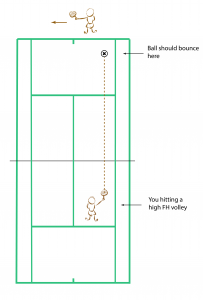
High FH Volley down the line
Technique:
Going down the line means your technique has to be even more perfect !! Why ? Because the distance from you (hitting spot) to the landing spot of your ball is shorter and the net is six inches higher (than for when you go crosscourt). So you have less space/area to hit into.
More depth on ground strokes
In this match Blanche’s depth on her groundstrokes was inconsistent. It would be wise for her to pay attention to this item. Obviously all these items which I have already mentioned must be maintained throughout the whole of the match
Always remember the five fundamental tactics….in order of priority.
Consistency, Depth, Placement, Power and Finesse.
Again, Blanche must remember which tactic is number 2 ?
Psychology …focus
Blanche made a good comeback from being down in the second set, so that was a good sign of mental strength. However two items pop up.
Having won the first set Blanche must learn that early in the second set is a critical time of the match. Blanche has the chance to put the match away (keep her foot down on the accelerator) OR relax and give the opponent the opportunity to get back into the match.
So Blanche needs to realize that she does tend to ease up once she has won the first set, and consequently be on the lookout for this to happen again………..and if she catches herself starting to ease up…..then nip it in the bud.
The other item is what I call the Margaret Court syndrome. In essence never lose focus/concentration. Margaret was famous for winning most first round matches 6-0, 6-0 !!! And often all over in twenty minutes.
Blanche needs to adopt this same attitude. Full concentration and get the match finished asap.
(Need pic of Margaret Court)
Margaret Court
The following pic was taken this year at the Australian Open. Levi (who is with her) is one of the Port Douglas Tennis Club’s good juniors. Levi is also a great student of the game and knows all about Margaret Court.
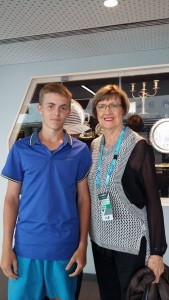
Levi Trewick and Margaret Court.
Good luck Blanche.
Alan Lane.

Recent Comments